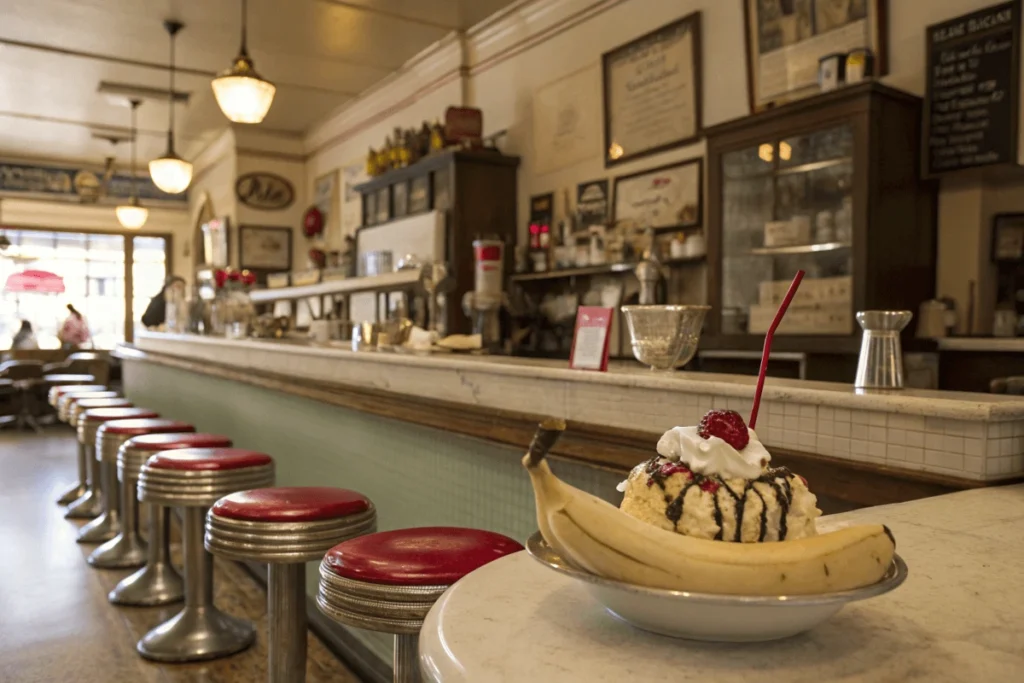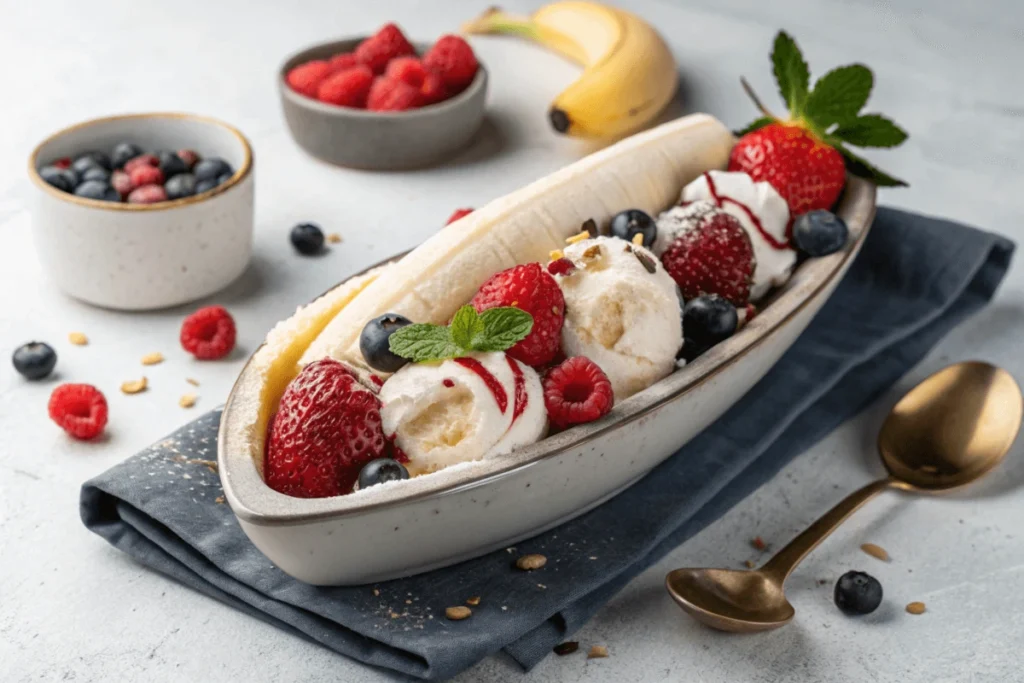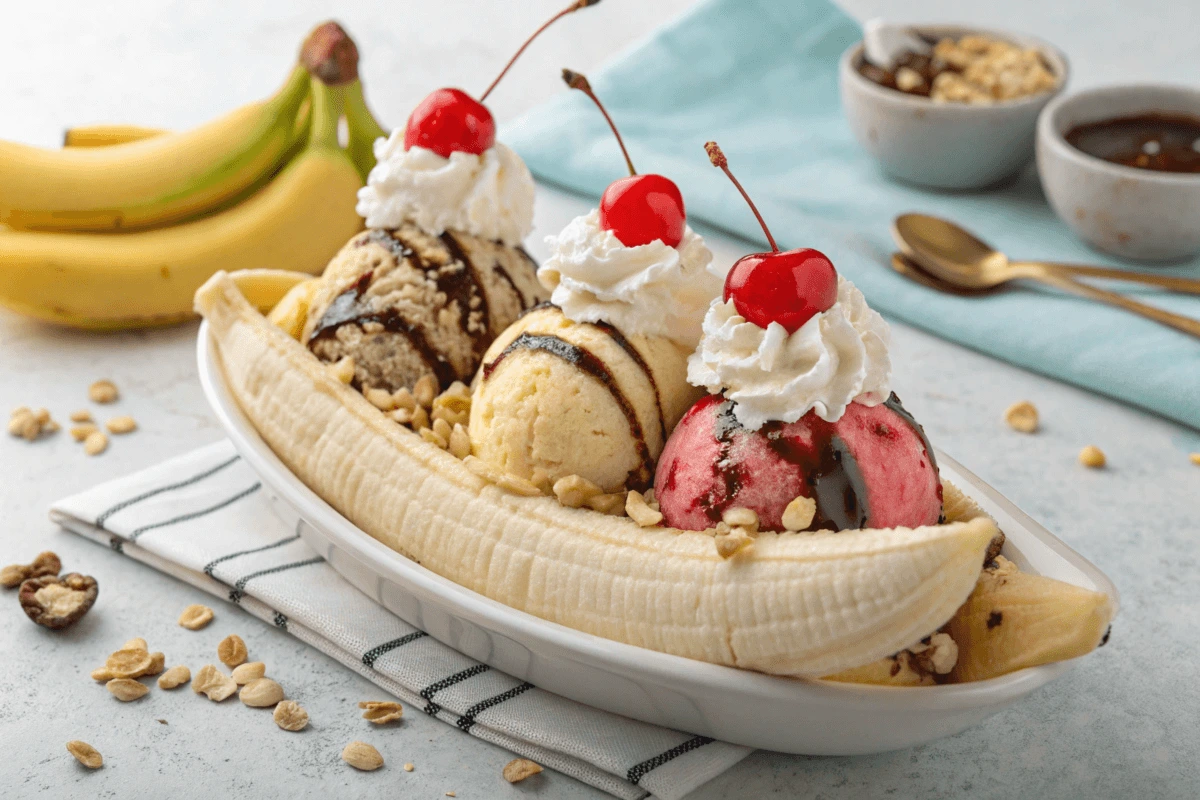The banana split is more than just a sweet treat; it’s a symbol of dessert creativity and fond memories. This famous dish has been enjoyed by many, with its layers of ice cream, banana halves, whipped cream, and toppings winning hearts around the world. But have you ever wondered why it’s called a banana split? This article looks at the rich history, cultural meaning, and changes of this classic dessert. Let’s dive in, starting with its irresistible charm.
Introduction to the Banana Split
The Enduring Appeal of a Timeless Dessert
The banana split is a favorite for good reason. With its mix of flavors, textures, and bright presentation, it has something for everyone. Picture this: ripe bananas holding scoops of smooth ice cream, topped with chocolate syrup, sprinkled with nuts, and finished with whipped cream and a cherry on top. This dessert is not just tasty—it’s a work of art.
Its charm lies in its simplicity and flexibility. Whether served at a fancy ice cream shop or made at home, the banana split gives off a feeling of celebration. The dish shows the joy of treating yourself, making it a must-have for special events and casual outings.
How It Became a Cultural Icon
The banana split didn’t just gain fame—it built a lasting legacy. It appeared during a time when soda fountains were popular meeting places, and this dessert quickly became a favorite across the country. Its unique look and customizable toppings made it even more appealing. Over time, this loved treat went from its simple start to becoming a dessert symbol, honored in festivals, media, and even national events like National Banana Split Day.
Historical Background of Ice Cream and Desserts
The Rise of Ice Cream in the Late 19th Century
In the late 1800s, ice cream became a popular treat in America. As technology improved, making ice more available, ice cream production grew. This creamy dessert became a staple at social events, fairs, and parlors, symbolizing indulgence and creativity. The growing love for ice cream set the stage for inventive desserts like the banana split to thrive.
How Soda Fountains Changed Desserts
Soda fountains turned into social spots in the early 1900s, mixing drinks and ice cream to create tasty treats. These places were where many classic desserts, including the banana split, were born. The fun experience of making sundaes and sodas kept customers coming back. This atmosphere encouraged soda jerks to try new ideas, leading to the creation of beloved desserts that are still popular today.

The Birth of the Banana Split
David Strickler and the 1904 Invention
In 1904, David “Doc” Strickler, a 23-year-old apprentice pharmacist in Latrobe, Pennsylvania, invented the banana split. Inspired by fruit-laden sundaes he encountered during a summer trip to Atlantic City, Strickler wanted to create something new upon returning home. He split a banana lengthwise, placed three scoops of ice cream between the halves, and topped it with syrups, whipped cream, nuts, and cherries. Priced at 10 cents—double the cost of regular sundaes—this indulgent treat quickly became a hit, particularly among students at nearby Saint Vincent College. Strickler’s creation not only delighted local patrons but also sparked a nationwide dessert trend.
Competing Claims: Who Else Might Have Invented It?
Though many credit Strickler with inventing the banana split, other towns have laid claim to its creation. In 1907, Ernest “Doc” Hazard of Wilmington, Ohio, reportedly created a similar dessert to attract college students during the winter months. He arranged three scoops of ice cream between split banana halves and topped them with chocolate, strawberry, and pineapple sauces, whipped cream, maraschino cherries, and nuts. Other potential inventors include Boston’s Butler Department Store and a confectioner in Davenport, Iowa. Despite these competing stories, most historians still recognize Strickler’s 1904 version as the original.
Exploring the origins of the banana split helps explain why it remains so beloved. The simplicity of its ingredients, creative presentation, and the lively atmosphere of soda fountains all contributed to its quick rise in popularity. As we continue to examine the history of this dessert, we’ll learn how it became a cultural icon and why it has maintained its charm over the years.
The Naming of the Banana Split
Why Is It Called a Banana Split?
The name banana split comes from the dessert’s preparation. It begins with a ripe banana, sliced lengthwise. This banana serves as the base for scoops of ice cream and a variety of toppings, such as chocolate, pineapple, and strawberry sauces. This straightforward presentation provides the perfect foundation for the indulgent layers that follow. The name emphasizes the simplicity of the dish, making it approachable, while also highlighting the star ingredient: the banana.
The Role of Bananas in Early 20th-Century America
In the early 1900s, bananas were a rare treat in America, introduced largely due to advances in transportation. Initially, bananas were expensive and considered a luxury item. However, as transportation improved, they became more affordable and easier to access. Their tropical flavor and bright yellow color quickly captured the attention of Americans. This new popularity made bananas a key ingredient in many desserts, including the banana split. Using bananas in this treat gave it a fresh twist, adding excitement and a sense of exoticism. Moreover, bananas were an ideal ingredient to combine with familiar items like ice cream, creating a mix of the known and the new. This combination appealed to the adventurous palates of the time, making the dessert even more exciting.
The Banana Split’s Golden Age
How It Became a Soda Fountain Staple
After its creation, the banana split quickly became a favorite in soda fountains across the United States. Its eye-catching presentation and delightful combination of flavors made it an obvious standout on any menu. Soda jerks, eager to show off their skills, took pride in crafting elaborate versions, adding unique twists like different syrups or extra toppings such as crushed nuts or sprinkles. In addition, the social atmosphere of soda fountains, where friends and families gathered, encouraged people to share this indulgent treat. The creative and theatrical preparation process, with its dramatic arrangement of ice cream scoops and vibrant toppings, helped solidify the banana split’s status as a staple at these venues. The vibrant energy of soda fountains only added to the appeal, making the dessert a must-try treat.
Cultural and Economic Factors Driving Popularity
Several factors contributed to the banana split’s rise in popularity during its golden age. Economically, the early 20th century saw a rise in disposable income, giving many Americans the freedom to indulge in treats. This increase in disposable income allowed more people to enjoy occasional luxuries, and the banana split was the perfect dessert for indulgence. Culturally, the era placed high value on social gatherings, and soda fountains, which served as community hubs, became ideal spots to enjoy this dessert. The banana split, with its shareable nature and customizable toppings, fit perfectly into this trend. It wasn’t just a dessert; it was a social experience. This blend of affordability, creativity, and social appeal helped the dessert solidify its place in American culture, becoming more than just a treat—it became a symbol of the era’s joyful spirit and community-focused lifestyle.
Check out our banana split cake recipe article.
Modern Twists on the Banana Split
Creative Variations on the Classic Recipe
While the original dessert remains a favorite, modern variations have added exciting new elements. For example, some chefs replace traditional ice cream with frozen yogurt or gelato, giving the treat a healthier twist. Others experiment with toppings, adding caramel, crushed cookies, or fresh berries to create unique flavor combinations. Vegan and dairy-free versions, made with plant-based ice cream and whipped toppings, cater to changing dietary preferences, making this dessert more inclusive.
Gourmet versions, featuring artisanal ice creams and handmade sauces, elevate the dessert to fine-dining status. This approach, for example, helps keep the dish fresh and appealing to modern tastes, offering a sophisticated twist on a nostalgic favorite. In addition, by using premium ingredients like homemade syrups or exotic fruits, chefs are pushing the boundaries of what this classic treat can become.
How Restaurants and Home Cooks Adapt the Tradition
Restaurants and ice cream parlors often add flair by serving it in oversized dishes or flambéing it for dramatic effect. Meanwhile, home cooks embrace its versatility by creating bite-sized versions or layering the ingredients into trifle bowls for parties. For example, these creative versions make it easier to serve large groups while maintaining the essence of the original.
No matter the twist, the heart of this dessert—its perfect balance of sweet, creamy, and fruity flavors—remains the same. Thus, this flexibility ensures the treat is loved by both those who enjoy the classic version and those who prefer more modern adaptations.

Cultural Celebrations and Recognition
National Day: A Day for Dessert Lovers
Every August 25th, dessert enthusiasts across the U.S. celebrate National Day. This annual event honors the dessert’s legacy, encouraging people to indulge in this iconic treat. Festivities often include eating contests, creative recipe competitions, and community gatherings, highlighting the treat’s ability to bring people together. Additionally, these events raise awareness of its origins, contributing to its ongoing popularity.
The Festival and Community Engagement
Latrobe, Pennsylvania, the birthplace of this treat, hosts an annual Festival to commemorate its creation. The festival, for example, features live music, local vendors, and, of course, plenty of the dessert. This vibrant celebration serves as a testament to the town’s pride in the dish’s origin. Similar festivals in other towns reflect its cultural impact, with many local events adding their own twist.
These celebrations highlight the cultural significance of the dessert, reinforcing its place as a symbol of American indulgence and shared joy. Therefore, the celebration goes beyond just enjoying a treat—it’s about preserving a piece of history and fostering community connections.
The Banana Split in Popular Media
Appearances in Film, TV, and Literature
The banana split often appears in popular media, symbolizing joy, nostalgia, and indulgence. In movies and TV shows, it’s commonly seen as a treat for celebrations or a playful dessert for kids. For instance, characters in classic sitcoms and animated series enjoy towering banana splits, showcasing its enduring charm. The banana split remains a universally loved sweet treat.
Additionally, in literature, the banana split sometimes represents carefree, simpler times. Writers use it to evoke nostalgia or highlight the vibrancy of American culture during the 20th century. Thus, these cultural references help reinforce its place in the collective memory, making it a lasting symbol of American desserts.
How Marketing Amplified Its Fame
The banana split owes much of its fame to clever marketing by soda fountains and ice cream parlors. For example, early advertisements focused on its whimsical presentation and luxurious toppings, appealing to families and young couples. As a result, the banana split became more than a dessert—it became an experience of fun and indulgence. On the other hand, the question Why is it called a banana split? is often raised in these ads, inviting customers to explore its intriguing history while enjoying the treat’s delightful flavors.
Frequently Asked Questions
Why Is It Called a Banana Split?
The name “banana split” comes from how the banana is sliced lengthwise to cradle the dessert’s ingredients. This unique presentation sets it apart from other sundaes, contributing to its appeal and iconic name, which evokes indulgence and fun.
Who Invented the Banana Split and When?
David Strickler, a pharmacy apprentice from Latrobe, Pennsylvania, invented the banana split in 1904. His inventive design quickly caught on, becoming a favorite across America. Thanks to Strickler’s creativity, the dessert became a defining part of American culture in the 20th century.
What Are the Core Ingredients in a Banana Split?
A traditional banana split includes a banana, three scoops of ice cream, chocolate, strawberry, and pineapple syrups, whipped cream, nuts, and a cherry. While modern variations exist, these classic ingredients give the dessert its perfect balance of flavors and textures.
How Has the Banana Split Changed Over Time?
Over the years, the banana split has evolved with creative variations and dietary adaptations. From vegan versions to gourmet renditions, it remains a versatile dessert that satisfies a wide range of tastes. Still, it is cherished for its blend of classic flavors and nostalgic roots.
The banana split continues to capture hearts, whether enjoyed in its classic form or as a modern twist. Thus, the question Why is it called a banana split? serves as a gateway into its rich history, continued popularity, and cultural significance.


1 thought on “Why is it called a banana split?”